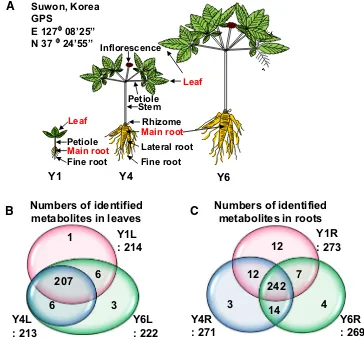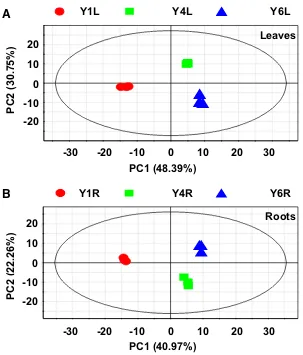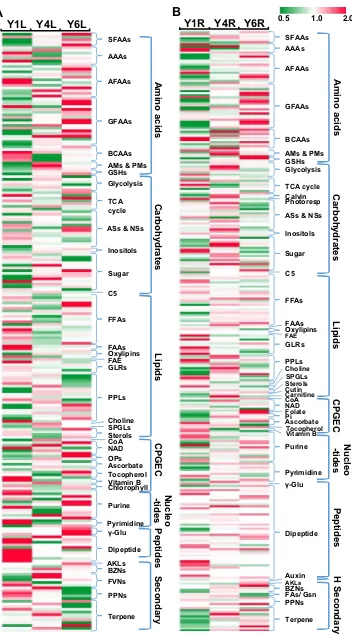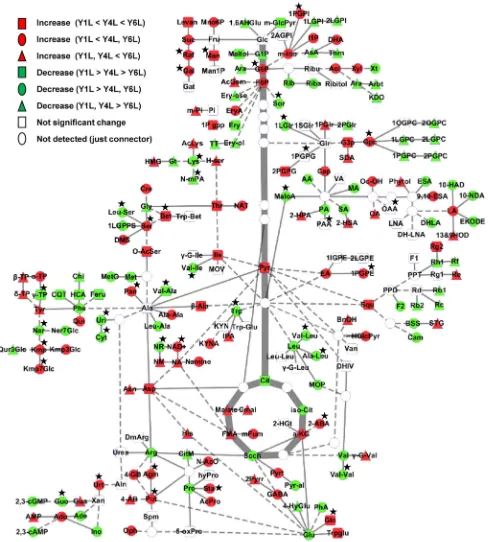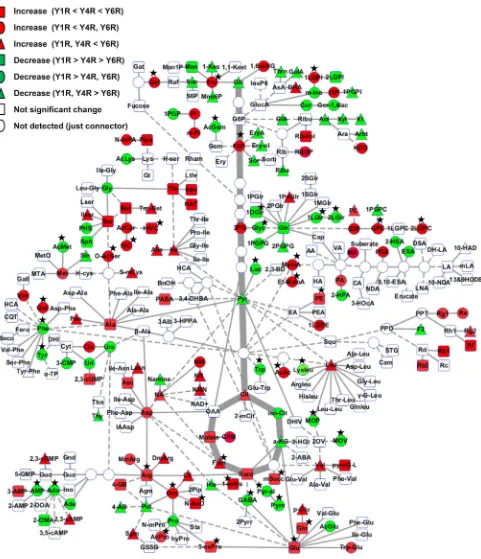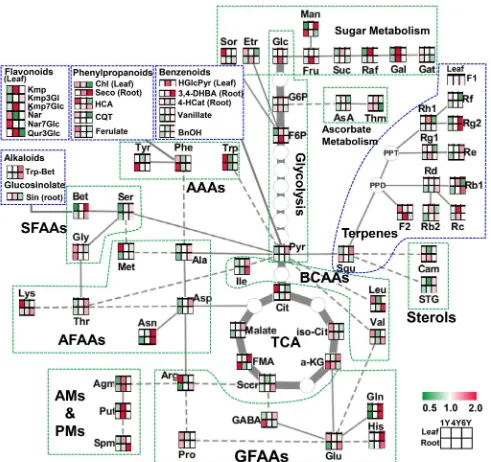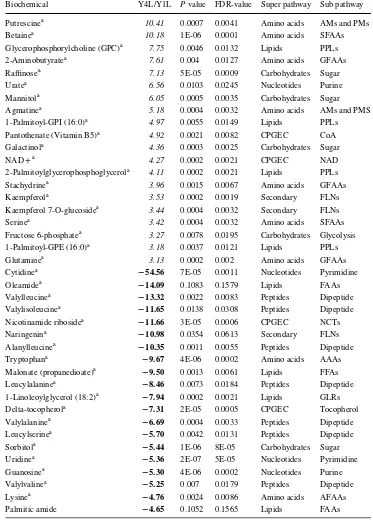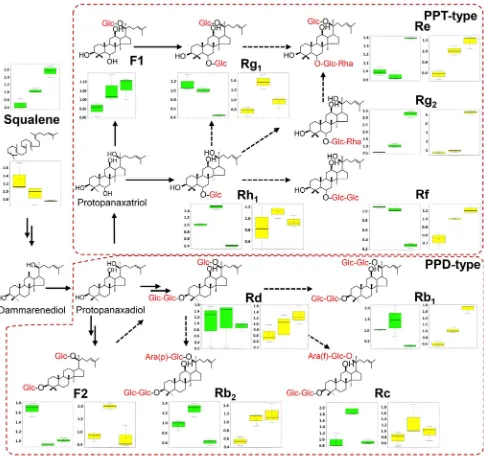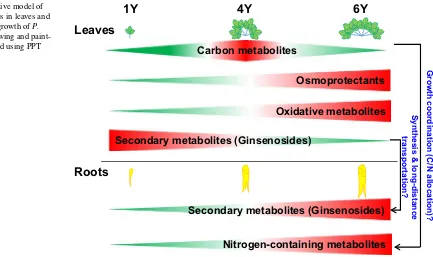1 23
Plant Cell Reports
ISSN 0721-7714 Volume 37 Number 3
Plant Cell Rep (2018) 37:393-410 DOI 10.1007/s00299-017-2236-7
adaptation of
Panax ginseng
during
development
Yu-Jin Kim, Sung Chul Joo, Jianxin Shi,
Chaoyang Hu, Sheng Quan, Jianping
1 23
ORIGINAL ARTICLE
Metabolic dynamics and physiological adaptation of
Panax ginseng
during development
Yu‑Jin Kim1,2 · Sung Chul Joo1 · Jianxin Shi2 · Chaoyang Hu2 · Sheng Quan2 · Jianping Hu3 · Johan Sukweenadhi1 · Padmanaban Mohanan4 · Deok‑Chun Yang1,4 · Dabing Zhang2,5
Received: 26 August 2017 / Accepted: 9 November 2017 / Published online: 17 November 2017 © Springer-Verlag GmbH Germany, part of Springer Nature 2017
Abstract
Key message The dynamics of metabolites from leaves to roots of Panax ginseng during development has revealed the tissue-specific and year-specific metabolic networks.
Abstract Being an essential Oriental medicinal plant, ginseng (Panax ginseng Meyer) is a slow-growing perennial herb-accumulating pharmaceutically active metabolites such as ginsenosides in roots during growth. However, little is known about how ginseng plants survive in the harsh environments such as winter cold and summer heat for a longer period and accumulates those active metabolites as the plant grows. To understand the metabolic kinetics in both source and sink organs such as leaves and roots of ginseng plant, respectively, and to assess the changes in ginsenosides biosynthesis during ginseng growth, we investigated the metabolic proiles from leaves and roots of 1-, 4-, and 6-year-old ield-grown ginseng plants. Using an integrated non-targeted metabolomic approach, we identiied in total 348 primary and secondary metabolites, which provided us for the irst time a global metabolomic assessment of ginseng during growth, and morphogenesis. Strik-ingly, the osmoprotectants and oxidized chemicals were highly accumulated in 4- and 6-year-old ginseng leaves suggested that ginseng develop a wide range of metabolic strategies to adapt unfavorable conditions as they mature. In 6-year-old plants, ginsenosides were decreased in leaves but increased in roots up to 1.2- to sixfold, supporting the view that there is a long-distance transport of ginsenosides from leaves to roots as ginseng plants mature. Our indings provide insights into the metabolic kinetics during the development of ginseng plant and this could complement the pharmacological importance of ginseng and its compounds according to their age.
Keywords Panax ginseng · Development · Ginsenosides · Metabolomics · Osmoprotectants
Introduction
Ginseng (Panax ginseng Meyer) is an adaptogenic herb in
the Araliaceae family that has been cultivated in East Asia
for thousands of years. The ginseng roots were shown to have antitumor, antidiabetic, antiaging, immune and improv-ing cognitive function and are rich in secondary metabolites
(Kim et al. 2015). Among the known metabolites in
gin-seng roots, triterpene saponins (also called ginsenosides) are nearly exclusively found in ginseng and widely recog-nized as the main active ingredient that contributes to its pharmacological eicacy. The backbone of ginsenosides are dammarenediol, which is being cyclized from squalene mostly via the mevalonic acid pathway (MVP) in the cyto-sol, including the protopanaxadiol (PPD) and the proto-panaxatriol (PPT) groups (Oh et al. 2014; Kim et al. 2015).
Communicated by Fumihiko Sato.
Yu-Jin Kim and Sung Chul Joo contributed equally to the work.
Electronic supplementary material The online version of this article (https://doi.org/10.1007/s00299-017-2236-7) contains supplementary material, which is available to authorized users.
* Yu-Jin Kim [email protected]
* Deok-Chun Yang [email protected]
* Dabing Zhang [email protected]
Ginseng is a slow-growing perennial herbaceous plant. The aboveground part shows distinct morphologies during vegetative development in diferent growth years. First-year (Y1) ginseng plant produces a single compound leaf without stem and in subsequent years until the fourth (Y4) to sixth (Y6) growth years, the plant develops more leaves that are attached to petioles on the stem (Fig. 1a). Ginseng plant starts to lower in the third year, and usually produce seeds from the fourth year. The tap root grows slowly during the irst 3 years, and increases in diameter from the fourth year to sixth year, and then it can be harvested. A Y6 ginseng root is about 7–10 cm in length, about 3 cm in diameter, and contains several lateral roots and abundant ine roots. It is regarded as the mature ginseng because it has the best mass and shape as well as the highest amounts of second-ary metabolites (Lin et al. 2010; Kim et al. 2015). During the ginseng cultivation, one major challenge is that ginseng plants are easily sufered from environmental stresses such as high light, salinity, and fungal infection, thus making them less survivable at Y6 (Shin et al. 2016). Intriguingly, ginseng roots accumulate more ginsenosides as they get older, whereas the leaves accumulate the maximal amount of ginsenosides during the irst or second growth year (Wang et al. 2006; Shi et al. 2007). We hypothesized that more
accumulated metabolites in older roots may be attributable to the high pharmacological value of Y6 roots. Systematic understanding on how ginseng plants synthesize, transport and accumulate metabolites in the leaves and roots during their growth remains scanty.
Recently, various metabolomics platforms including nuclear magnetic resonance spectroscopy (NMR) and liq-uid chromatography–mass spectrometry (LC/MS) have been successfully used to identify cultivation age of ginseng (Shin et al. 2007, 2016; Lin et al. 2010; Kim et al. 2011; Yang et al. 2012; Shan et al. 2014; Xiao et al. 2015; Liu et al.
2017a). Metabolic proiling using LC/MS was successfully applied to discriminate Panax species or organs (Dan et al.
2008; Yang et al. 2013; Chen et al. 2014; Mao et al. 2014; Park et al. 2014; Qiu et al. 2016). However, these studies mainly focused on the authentication of commercialized ginseng products and mostly targeted ginsenosides. Using gas chromatography–mass spectrometry (GC/MS), 11 fatty acids and 23 nonpolar primary metabolites were identiied from Panax of diferent ages (Zhang et al. 2013a, b; Cui et al. 2015), and 91 and 109 metabolites were identiied from 2- to 5-year-old roots and 1- to 5-year-old diferent tissues of
P. ginseng, respectively (Cui et al. 2015; Liu et al. 2017b).
A study using Fourier transform infrared spectral analysis
Fig. 1 Geographic location, morphology, and detection of metabolites in diferent ages and tissues of Panax ginseng. a Dif-ferent morphologies of ginseng plants during development. Comparison of the number of metabolites identiied from leaves (b) and roots (c). The drawing and painting were produced using PPT software by Kim and Joo based on Table S1
to discriminate ginseng leaves of 1- to 3-year-old suggested that the metabolome of ginseng leaves get alter depending on the age of the plant (Kwon et al. 2014). Despite these insights provided by abovementioned studies, fewer studies have focused on the metabolic kinetics of whole metabo-lites both in ginseng leaves and roots along diferent growth years.
To reveal the metabolic change along ginseng develop-ment, we examined metabolomic proiles in the source tissue leaves and the sink tissue roots from Y1, Y4, and Y6 plants, using an integrated GC/MS and ultra-performance liquid chromatography (UPLC)/MS/MS. We identiied a total of 348 primary and secondary metabolites in ginseng tissues. Notably, the number of identiied metabolites was at least three times higher than those of previous analyses of gin-seng plant or related species. Remarkable dynamic changes of metabolites were observed in ginseng roots and leaves along the ginseng development, which were in good agree-ment with the developagree-mental stage induced physiological and morphological changes. Moreover, our results suggested a low of ginsenosides from the leaf to the root as ginseng matures, providing important insights into how ginsenosides accumulate in ginseng roots.
Results
Metabolic proiling of ginseng leaves and roots
To understand the global metabolic changes in ginseng dur-ing its development, we collected leaves and roots from Y1, Y4 and Y6 ginseng plants. Using an established metabolic proiling approach with GC/MS and UPLC/MS/MS, we identiied 323 and 416 metabolites from leaves and roots, respectively; among them, 223 metabolites from leaves and 293 from roots had known structures while the remaining were unknown. From the total population, we assessed 348 metabolites with known structures, out of those 55 metabo-lites were from leaves and 125 were from roots speciically, and 168 metabolites were found common to both leaves and roots (Table S1, Fig. 1b). The number of identiied metabo-lites was much higher than previous metabolic studies in ginseng plants, which facilitated further statistic analyses.
Those 348 metabolites of known structures have covered most of the known central metabolic pathways in plants, thus relecting the inal results of the corresponding physi-ological activities of ginseng leaves and roots in the tested three developmental stages. These metabolites were mapped onto eight metabolic super-pathways and their underlying 47 sub-pathways (Table S2), as deined by the Plant Metabolic Net (PMN) and Kyoto Encyclopedia of Genes and Genomes (KEGG). They included primary metabolites such as most amino acids and their derivatives, carbohydrates, lipids,
cofactors, prosthetic groups and electron carriers (CPGECs), nucleotides, as well as 32 secondary metabolites.
Global metabolic changes in diferent growth years
To obtain a global view of the metabolic changes during ginseng development, principal component analysis (PCA) was performed on the identiied metabolites. PCA showed a clear separation of metabolites among Y1, Y4, and Y6 leaves (Fig. 2a) and roots (Fig. 2b). In leaves, the irst prin-cipal component (PC1), which accounted for 48.39% of the total variance, separated young leaves (Y1L) and mature leaves (Y4L and Y6L). Similarly, the second principal component (PC2), which accounted for the left 30.75% of the total variance, separated Y4L from Y6L. In roots, PC1 and PC2 that accounted for 40.97% and the left 22.26% of the total variance, respectively, resolved the classiication of Y1R, Y4R, and Y6R. Finally, the metabolomes of Y1L and Y1R were distinguishable from the corresponding tissue samples of other growth years, consistent with the distinc-tive morphological and developmental features of irst-year plants (Fig. 1a).
Hierarchical cluster analysis revealed considerable changes in the levels of a wide range of amino acids, carbo-hydrates, fatty acids, cofactors and secondary metabolites in leaves and roots across the ginseng development (Fig. 3, Tables S3, S4). The levels of many amino acids increased while the amount of several lipids and peptides decreased over growth years in both leaves and roots. Notably, the main diference in metabolites between leaves and roots were in secondary metabolites which showed decreased levels of phenylpropanoids and terpenoids in Y6L while increased levels of them in Y6R (Fig. 3).
Speciic metabolic changes in diferent growth years of leaves and roots
Amino acid metabolism
serine family amino acids (SFAAs), except the precursor Gly, increased to threefold in roots and in leaves (Fig. 6). Consistent with the high accumulation of Ser in Y6L and Y6R, betaine, an osmoprotectant associated with drought/ salt response in plants (Ros et al. 2014), was the highest accumulated metabolite in Y4L (tenfold) and Y6L (27-fold) as compared with that in Y1L (Tables 1; S3, S5).
Free amino acids, water soluble proteins, peptides, amines, free nucleotides, nucleic acid bases and alkaloids were highly accumulated in ginseng roots, which may facilitate the accumulation of metabolites as the ginseng root increases in size after 4 years (Fig. 4). High accumu-lation of N-containing metabolites in ginseng roots may contribute to the Y6R roots in terms of resisting roots, hence the better weight, shape, and quality of Y6R. Pre-viously, peptides in ginseng root possibly have the func-tion of potentially antilipolytic, and antidiabetic activities (Ando et al. 1980; Ye et al. 2016), thus we speculate that the high level of peptides in ginseng roots contributes to ginseng pharmacological activities.
Sugar and lipidic metabolites
The Y4L accumulated the highest level of sucrose (Fig. 3), suggesting a high demand of carbohydrates in leaves (source organ) of Y4-plants. Among the changes in leaves over the developmental time course, mannitol was heav-ily loaded and almost 50-fold higher in Y6L than in Y1L (Tables 1; S5). In addition, several other carbohydrates associated with the rainose family of the oligosaccha-ride (galactinol, rainose), as well as fructose and xylose showed a higher proile in Y4L and Y4R (Tables S3, S4). Similarly, fructose 6-phosphate, a metabolite with a cen-tral role in primary carbohydrate metabolism, accumulated strongly in Y4L (3.3-fold) and Y4R (3.6-fold) compared to irst-year samples (Tables 1, 2), but decreased in Y6L and Y6R (Tables S3, S4). Interestingly, in contrast to highly accumulated mannitol that is derived from fructose 6-phosphate, the osmolyte sorbitol derived from glucose 6-phosphate was signiicantly lower in Y4L and Y6L (-5-fold) (Table S5).
Most of the free fatty acids, including 16:0 palmitate and 18:0 stearate, decreased in Y4L. However, the oxidized fatty acid intermediates, 2-hydroxypalmitate and 2-hydroxysterate
accumulated in Y6L to 17.8- and 6.1-fold, respectively (Table S5), indicating that ginseng plants, particularly aboveground organs, may undergo an increased level of
Fig. 4 Ginseng leaf metabolome. The identiied 223 metabolites are mapped on a simpliied metabolic network. Squares, circles and tri-angles denote metabolites detected in this study. Blank circles repre-sent undetected metabolites that are used just for the connection of
oxidative stress. The reduction in linoleic acid phospholip-ids, which exist as the most abundant fatty acid in ginseng root (Zhang et al. 2013b), and the elevation of free fatty
acids and other intermediates such as glycerophosphoryl-choline (GPC) (Fig. 3; Tables 2; S6) support the notion that membrane lipids are remobilized for defense (Khajuria et al.
Fig. 5 Ginseng root metabolome. The identiied 293 metabolites are mapped onto a simpliied metabolic network. Squares, circles and tri-angles denote metabolites detected in this study. Blank circles repre-sent undetected metabolites used just for connecting the metabolites.
2013) and suggest the existence of an active defense system in Y6 via reprogramming lipid metabolic pathways.
Cofactors and nucleotides
The metabolomics analysis has revealed that the amount of CPGEC accumulated in leaves as the ginseng grew. Nico-tinamide riboside, the precursor of NAD or nicoNico-tinamide, accumulated in Y1L and highly decreased in Y4L (11-fold) and Y6L (17-fold) (Table 1; S5), possibly contributing to
the escalation of NAD + in Y4L (4.3-fold) and further rise of nicotinamide (8.7-fold) and nicotinate (threefold) in Y6L than Y1L. The reduction of uracil (twofold) together with the increase of 3′-CMP (3.6-fold) during root growth (Table S6) possibly suggest the supply of pyrimidine nucleo-tides for the biosynthesis of phospholipids or polysaccha-rides for root growth and RNA and DNA synthesis (Katahira and Ashihara 2002).
Many antioxidant metabolites including vitamins B, C, and E showed obvious changes in ginseng leaves as plants
Fig. 6 Overview of connections between primary metabolism and major secondary metabolic pathways in P. ginseng leaves and roots during development. Heat maps of metabolite changes in primary metabolites (green dashed lines) including amino acids and
aged. Pantothenate (vitamin B5), which is important for coenzyme A (CoA) synthesis, accumulated remarkably in Y4L (ivefold) and Y6L (3.5-fold) as compared with
that of Y1L (Tables 1; S5). Alpha-tocopherol, the major
vitamin E in chloroplast membranes to quench reactive
oxygen species (ROS) and protect lipid from peroxyda-tion during photooxidaperoxyda-tion or oxidative stress (Munn`e
and Alegre 2002), accumulated in Y4L (1.5-fold) and
Y6L (1.6-fold). Furthermore, β-tocopherol accumulated to fourfold in Y6L (Table S5), indicating the activation of
Table 1 Top 40 metabolites showing strong changes in Y4L compared with Y1L
Italic and bold values indicate that the mean values are signiicantly higher and lower, respectively a Indicates metabolites responsible for the separation by PLS-DA. P value and FDR-value indicate the sig-niicance and false discovery rate of diference of the relative metabolite levels between Y1L and Y4L, respectively
Biochemical Y4L/Y1L P value FDR-value Super pathway Sub pathway
Putrescinea 10.41 0.0007 0.0041 Amino acids AMs and PMs
Betainea 10.18 1E-06 0.0001 Amino acids SFAAs
Glycerophosphorylcholine (GPC)a 7.75 0.0046 0.0132 Lipids PPLs 2-Aminobutyratea 7.61 0.004 0.0127 Amino acids GFAAs Rainosea 7.13 5E-05 0.0009 Carbohydrates Sugar
Uratea 6.56 0.0103 0.0245 Nucleotides Purine
Mannitola 6.05 0.0005 0.0035 Carbohydrates Sugar Agmatinea 5.18 0.0004 0.0032 Amino acids AMs and PMS 1-Palmitoyl-GPI (16:0)a 4.97 0.0055 0.0149 Lipids PPLs Pantothenate (Vitamin B5)a 4.92 0.0021 0.0082 CPGEC CoA Galactinola 4.36 0.0003 0.0025 Carbohydrates Sugar
NAD + a 4.27 0.0002 0.0021 CPGEC NAD
2-Palmitoylglycerophosphoglycerola 4.11 0.0002 0.0021 Lipids PPLs Stachydrinea 3.96 0.0015 0.0067 Amino acids GFAAs
Kaempferola 3.53 0.0002 0.0019 Secondary FLNs
Kaempferol 7-O-glucosidea 3.44 0.0004 0.0032 Secondary FLNs
Serinea 3.42 0.0004 0.0032 Amino acids SFAAs
Fructose 6-phosphatea 3.27 0.0078 0.0195 Carbohydrates Glycolysis 1-Palmitoyl-GPE (16:0)a 3.18 0.0037 0.0121 Lipids PPLs
Glutaminea 3.13 0.0002 0.002 Amino acids GFAAs
Cytidinea − 54.56 7E-05 0.0011 Nucleotides Pyrimidine
Oleamidea − 14.09 0.1083 0.1579 Lipids FAAs
Valylleucinea − 13.32 0.0022 0.0083 Peptides Dipeptide Valylisoleucinea − 11.65 0.0138 0.0308 Peptides Dipeptide Nicotinamide ribosidea − 11.66 3E-05 0.0006 CPGEC NCTs Naringenina − 10.98 0.0354 0.0613 Secondary FLNs Alanylleucinea − 10.35 0.0011 0.0055 Peptides Dipeptide Tryptophana − 9.67 4E-06 0.0002 Amino acids AAAs Malonate (propanedioate)a − 9.50 0.0013 0.0061 Lipids FFAs Leucylalaninea − 8.46 0.0073 0.0184 Peptides Dipeptide 1-Linoleoylglycerol (18:2)a − 7.94 0.0002 0.0021 Lipids GLRs Delta-tocopherola − 7.31 2E-05 0.0005 CPGEC Tocopherol Valylalaninea − 6.69 0.0004 0.0033 Peptides Dipeptide Leucylserinea − 5.70 0.0042 0.0131 Peptides Dipeptide Sorbitola − 5.44 1E-06 8E-05 Carbohydrates Sugar Uridinea − 5.36 2E-07 5E-05 Nucleotides Pyrimidine Guanosinea − 5.30 4E-06 0.0002 Nucleotides Purine Valylvalinea − 5.25 0.007 0.0179 Peptides Dipeptide
Lysinea − 4.76 0.0024 0.0086 Amino acids AFAAs
antioxidant defense mechanisms in aging ginseng leaves. Moreover, the increase in these metabolites could prevent the Y4L and Y6L from the accumulated oxidized fatty acids in the mature leaves.
Secondary metabolites
We observed abundant terpenoids, including 11 major gin-senosides as the ginseng ages, in correlation with a previous
Table 2 Top 40 metabolites showing strong changes in Y4R compared with Y1R
Italic and bold values indicate that the mean values are signiicantly higher and lower, respectively a Indicates metabolites responsible for the separation by PLS-DA. P value and FDR-value indicate the sig-niicance and false discovery rate of diference of the relative metabolite levels between Y1R and Y4R, respectively
Biochemical Y4R/Y1R P value FDR-value Super pathway Sub pathway
Malonate (propanedioate)a 10.59 0.0027 0.021 Lipids FFAs Beta-hydroxyisovaleroylcarnitinea 10.31 0.0148 0.0481 Amino acids BCAAs
Glutaminea 9.04 5E-06 0.0007 Amino acids GFAAs
2-Linoleoyl-GPC (18:2)a 7.03 0.0015 0.0158 Lipids PPLs Glycerophosphorylcholine (GPC)a 6.50 0.0008 0.0134 Lipids PPLs
Quinatea 6.48 0.0002 0.0037 Amino acids AAAs
O-Acetylserinea 5.37 0.0013 0.0147 Amino acids SFAAs
Ethylmalonatea 5.27 0.0067 0.0326 Lipids FFAs
1-Methylhistidinea 4.22 0.0028 0.0209 Amino acids GFAAs Phosphoethanolamine (PE)a 4.00 0.0065 0.0322 Lipids PPLs Isovalerylcarnitine (C5)a 3.99 0.0017 0.0159 Amino acids BCAAs
Ornithinea 3.89 0.0087 0.0374 Amino acids GFAAs
Glutamatea 3.84 0.0012 0.0151 Amino acids GFAAs
N-Acetylprolinea 3.77 0.0002 0.0036 Amino acids GFAAs Fructosea 3.74 0.0153 0.0494 Carbohydrates Sugar
Argininea 3.73 4E-05 0.0015 Amino acids GFAAs
5-Oxoprolinea 3.71 2E-05 0.0011 Amino acids GSHs Fructose 6-phosphatea 3.58 0.0119 0.0426 Carbohydrates Glycolysis Galactinola 3.56 0.0135 0.0464 Carbohydrates Sugar
N-delta-acetylornithinea 3.35 3E-05 0.0012 Amino acids GFAAs 1-Linoleoyl-GPI (18:2)a − 7.57 2E-07 7E-05 Lipids PPLs 1-Linoleoylglycerol (18:2)a − 6.07 0.0474 0.1208 Lipids GLRs 4-Methyl-2-oxopentanoatea − 5.15 0.0019 0.0172 Amino acids BCAAs 3-Methyl-2-oxovaleratea − 5.01 0.0006 0.0098 Amino acids BCAAs
Pyridoxala − 4.75 0.0103 0.0394 CPGECs Vitamin B
2-Linoleoylglycerol (2-monolinolein)a − 4.43 0.0034 0.0226 Lipids GLRs Tryptophana − 4.38 0.0102 0.0394 Amino acids AAAs Lysylleucinea − 4.37 0.0001 0.0035 Peptides Dipeptide
N-Acetylglucosaminea − 4.05 7E-06 0.0007 Carbohydrates Ass and NSs
AMPa − 3.89 3E-05 0.0015 Nucleotides PURs
Fumaratea − 3.70 0.0681 0.1523 Carbohydrates TCA Phenylalaninea − 2.65 0.001 0.0134 Amino acids AAAs 1-Oleoylglycerol (18:1)a − 2.61 0.0089 0.0378 Lipids GLRs
N-Acetylmethioninea − 2.50 0.0182 0.0567 Amino acids AFAAs
Tyrosinea − 2.27 0.0075 0.0343 Amino acids AAAs
study which used terpenoids to distinguish ginseng ages (Cui et al. 2015). In this study, we detected an increase of squalene, the precursor of ginsenosides derived from the mevalonic acid pathway, in Y4L (1.5-fold) and Y6L (2.3-fold) compared to Y1L, while there was no significant decrease of squalene content in root during growth. These indings were in consistent with the medicinal importance of ginseng roots, ginsenosides accumulated dramatically to 1.2- to sevenfold in root as the plant grew (Fig. 7; Table S4). Among the 40 diferent ginsenosides that have been identi-ied and isolated from diferent tissues of P. ginseng, the
major ginsenosides in roots and leaves are the PPD-type Rb1, Rb2, Rc, and Rd, and the PPT-type Re, Rg1 and Rf, respectively, which normally account for more than 80% of the total ginsenosides in P. ginseng (Kim et al. 2015). Our metabolomic analysis identiied seven of these major gin-senosides as well as other PPD- and PPT-type gingin-senosides such as F2, Rg2, Rh1, and F1.
Ginsenosides accumulated continuously in roots as plants grew, even though the reported total ginsenoside content and ginsenoside proiles vary among diferent studies (Kim et al.
2015). In our study, nearly all the detected ginsenosides in
Fig. 7 Ginsenoside metabolic pathways and the changes of ginseno-side metabolites in diferent years. Dashed arrows represent putative pathways. Green and yellow graphs represent metabolic changes in
roots increased over the time (Fig. 7). All of the ten detected ginsenosides accumulated significantly in Y4R, among which ginsenoside Rb1 and Rg2 continued to increase in Y6R. The level of ginsenoside Rg2 was sevenfold higher in Y6R than Y1R (Table S4). Rb1’s increase in root and decrease in leaves during its growth was consistent with pre-vious reports (Wang et al. 2006; Shi et al. 2007; Kim et al.
2012), conirming that Rb1 can be used as a marker for Y6R (Kim et al. 2012).
Leaves contained a reduced level of ginsenosides com-pared with roots (Fig. 7), which was consistent with previous reports (Wang et al. 2006; Shi et al. 2007). Most ginseno-sides including Rb1, Rb2, Rg1, Rf, and Rh1 showed lower levels in Y6L than Y1L (Table S3), which was diferent from previous studies (Shi et al. 2007; Li et al. 2012). This vari-ation in individual ginsenosides may be caused by diferent growth stage and harvest time, and/or soil environment (Kim et al. 2011; Chen et al. 2013). Interestingly, unlike other ginsenosides, the levels of Re and Rg2 increased two- and sixfold in Y6L from Y1L (Table S5; Fig. 7).
Phenolic compounds have been reported to have anti-oxidant activity in ginseng (Chung et al. 2012). Alkaloid (tryptophan betaine) and phenolics (ive benzenoids and ive phenylpropanoids) besides ginsenosides accumulated
in Y4R or Y6R as compared with those in Y1R (Fig. 3,
Table S4), suggesting that ginseng roots accumulate mostly carbon (C)-based secondary metabolites, this correlates to the high medicinal value of older ginseng roots. Here, we identiied lavonols including kaempferols and quercetin, and lavanone naringenin in leaves, but not in roots. Kaemp-ferol and kaempKaemp-ferol 7-O-glucoside were increased highly
in Y4L as compared with those in Y1L, while quercetin
3-O-glucoside increased in Y4L but decreased highly in
Y6L (Table S5), supporting the view that antioxidants are highly accumulated in old ginseng leaves to prevent oxida-tive stress (Agati et al. 2012). Consistent with the previous indings (Chung et al. 2012), the levels of benzenoids, such as vanillate, and benzyl alcohol, a type of phenolic acid, and antioxidant polyphenol were increased in Y4R or Y6R. However, most phenylpropanoids were not signiicantly changed in roots, except the high accumulation of secoiso-lariciresinol in Y6R (Table S4).
Discussion
Understanding metabolic changes during plant develop-ment allows us to reveal the biochemical pathways that control development and physiological status (Kooke and
Keurentjes 2011). However, metabolic diversity in most
medicinal plants that have nutritional, pharmaceutical and chemical importance is poorly characterized. Here we pre-sent the irst global scenario of ginseng metabolism in asso-ciation with growth, development, and morphology (Fig. 8), which demonstrates tissue-speciic and year-speciic meta-bolic networks within ginseng plants.
Dynamics of metabolites during development
Ginseng is a slow-growing medicinal plant that generally requires at least 4–6 years of cultivation before harvest. Pre-vious metabolomic approaches using NMR spectroscopy
and UPLC-Q-Tof MS-based non-targeted metabolomic analysis have been mainly used to discriminate ginseng roots in diferent cultivated years, which lacked a clear identiication of metabolites from ginseng plants (Lin et al.
2010; Kim et al. 2011, 2012; Kwon et al. 2014), let alone the dynamic patterns. In this study, we used non-targeted metabolomic proiling to identify various primary and sec-ondary metabolites, with those identiied metabolites we could clearly diferentiate Y1 from Y4 and Y6 samples and leaves from roots (Fig. 2). Notably, we observed remark-able growth year dependent alterations in many metabolites such as N-containing metabolites, sugars and fatty acids in both leaves and roots of ginseng (Figs. 3, 4). Especially, the accumulation of amino acids and other N-containing metabolites such as ornithine, and polyamines in both leaves and roots as plants mature in Y4 and Y6 indicated that those metabolites are likely important for the increase of size and ginsenosides contents of roots. In addition, our non-targeted metabolomics analysis also identiied vitamin precursors, stigmasterol and natural antioxidants. The levels of natural antioxidants and ginsenosides in roots increased as ginseng plants grow (Tables S3, S4), consistent with the view that older ginseng has more beneicial and pharmacological ei-cacy to human beings than the younger roots.
Dynamic C/N metabolism in roots and leaves
Changes in the level of soluble sugars were suggested to link plant metabolism with the environment, as sugar levels are inluenced by both sink activities and biotic/abiotic stresses
(Geigenberger 2011). Rainose and galactinol, which were
found to accumulate in both Y4L and Y4R in our study, were documented to be defense-response osmoprotectants under salt and drought stresses (Nishizawa et al. 2008). Sugar alcohols, mannitol and sorbitol have been linked to stress tolerance, especially tolerance against salinity and drought stresses (Chen et al. 2005). In Y6L, the dramatic increase of mannitol was sharp in contrast to the decrease of sorbitol (Table S5), which is also a stress-induced osmoprotectant. This observation implies that mannitol may be the preferred osmoprotectant in aged ginseng leaves. The increase of gly-colysis components in Y4L and Y4R indicates active respi-ration for energy production, which was also supported by the high level of NAD+ at this stage (Fig. 5; Tables 1, 2).
Y6R accumulated high levels of Glu, Gln, Asp, Asn and their derivates (Table S6), which are considered as the sensor of N status (Chen et al. 2005). However, these mol-ecules decreased continuously in leaves as ginseng aged, implying the critical role of N-derived metabolites in the development of ginseng roots. In addition, the reallocation of N that has been stored as protein reserves is important for the spring growth of perennials (Rentsch et al. 2007). In ginseng, the high level of Gln was shown to be related
to the low-branching and slow-growing hairy root in vitro (Jung et al. 2006). Therefore, this N assimilation could be an important factor in regulating ginseng root morphology during long time cultivation.
C/N ratio has been reported to be a key signal in plant
growth and development (Nunes-Nesi et al. 2010
; Balaza-deh et al. 2014). Our observation of the predominance of N-transporting amino acids and derivates in aged leaves and roots, in contrast to the decreased level of the C status at the Y6 stage, suggests a general imbalance of C/N in roots that point toward a C deicit. C supply is largely connected to the photosynthetic activity in source leaf (Kooke and Keurentjes
2011). Ginseng has less number of stomata (Lee 1988) and thinner leaves which contain mostly sponge-type meso-phyll cells without clearly distinguished compact palisade cells (Park 1980), which may cause reduced photosynthetic rate. These accumulated C/N sources might compensate the reduced levels of photosynthesis and photorespiration metabolites after 4 years of growth.
From an evolutionary point of view, we propose that ginseng has become a slow-growing plant after adaptation to the reduced energy requirement under limited photosyn-thesis and osmotic stress exposure, as slow-growing plants are generally found in low nutrient and stressful environ-ments (Atkinson et al. 2012). Wild ginseng that has been grown in nature for hundreds of years develops smaller root and a slow growth rate compared with ield-grown ginseng. Cultivated ginseng increases the number of leaves each year, whereas wild ginseng increases leaf numbers every 3–5 years and eventually produces 4–6 compound leaves. Therefore, we hypothesize that the diiculty of cultivating ginseng for more than 6 years in the ield may be caused by a limited C supply from leaves. Supporting our hypoth-esis is the inding that compared with ginseng grown in the ield, hydroponically cultured ginseng grows more quickly as it receives suicient light and N supply (Kim et al. 2010). Taken together, C metabolism and N allocation are impor-tant for ginseng root development and C deiciency may be the major limitation for ginseng growth in the ield.
Ginseng accumulates defense metabolites during growth
to Met increased in Y6L, suggesting that Y6 plants have undergone oxidative stress. The reduced level of ascor-bate and increased level of dehydroascorascor-bate in ginseng leaves as plants grow older (Fig. 5) is consistent with the age-dependent oxidative stress imposed on the plant (Sup-plemental Fig. 1). Thus, increased oxidative stress and loss of membrane integrity are key characteristics of aging in ginseng. However, ginseng plants contain higher levels of antioxidants against ROS production in Y6 than Y4 plants, suggesting stress adaption in aged plants by balancing the production and quenching of ROS.
Given that aged ginseng leaves contain more osomopro-tectants (Fig. 8), and accumulated salts in the ield with 4- to 6-years’ cultivated ginseng, we postulate that these plants are mainly sufering from osmotic stress. It is striking that compounds with strong osmotic properties, such as the sugar alcohol mannitol, quaternary ammonium compounds, and GPC, are highly accumulated in Y6L (Tables 1; S5). Nota-bly, we found that in ginseng plants, amino acid-derived metabolites including GABA and polyamines accumulated in aging leaves. The accumulated stachydrine in Y4L is known as an osmoprotectant that is especially related to salinity stress (Trinchant et al. 2004). Therefore, our metabo-lomic analyses illustrate that ginseng has developed a whole range of strategies to adapt its metabolism to unfavorable growth conditions and that enhanced stress resistance is not due to the action of a single compound.
Accumulation and long‑distance transport of ginsenosides
Although ginseng root is used for medicinal purpose, gin-senosides are distributed in all tissues. Ginsenoside concen-trations luctuate dramatically in response to environmental stimuli such as salt, light, JA, and other signaling molecules (Oh et al. 2014; Rahimi et al. 2015). In plants, diferent envi-ronmental circumstances evoke diferent efects on the bal-ance between primary and secondary metabolisms. Under nutrient-limiting or stressful environments, plants grow slower because they allocate more resources to constitu-tive defense (Endara and Coley 2011). In support of these views, low nitrate concentrations could induce ginsenoside production in cell culture (Liu and Zhong 1997), whereas ginseng roots cultured by high-N hydroponics display faster growth but lower ginsenoside contents (Kim et al. 2010). As osmotic stress could cause growth inhibition but stimulate the accumulation of secondary metabolites including gin-senosides (Wu et al. 2005), we propose that many second-ary metabolites in ginseng might be produced for defense response. Little is known about the physiological role of gin-senosides in plants beside the major role as defense against pathogens (Nicol et al. 2002; Kochan et al. 2013). Recent studies, however, revealed its association with plant growth
(Zhang et al. 2011) and ginsenosides’ diferent localizations at cortex, xylem and periderm in diferent ages of root (Lee et al. 2017). In addition, contents of ginsenosides and total ginsenosides are not positively correlated with 5- to 18-year-old ginseng root (He et al. 2016), contents of ginsenoside Rb1, Rc, and Rd varied widely with ages in samples from diferent cultivation regions (Xiao et al. 2015), and changes in the ratio of Re and Rg1 are dependent on the harvest season (Liu et al. 2017a), suggesting that ginsenosides accu-mulation varies to physiological status. Diferent change pat-terns of individual ginsenosides in leaves and roots along plant growth (Fig. 7) may be associated with their diferent biological activities in plant growth (Kim et al. 2015), which remains to be further comprehensively elucidated.
The level of squalene, the precursor of ginsenosides, was increased in leaves and decreased in roots over growth years (Fig. 7). It suggests the active biosynthesis of ginsenosides or their precursors in leaves and their dynamic transport into the root. In agreement with this hypothesis, Schramek et al. (2014) proposed that derivatives of photosynthetic metabo-lites such as glucose and fructose contribute to the synthesis for ginsenosides glycosylation or its movement into roots. More recently, Liu et al. (2017b) proposed that higher rates of photosynthesis and higher energy consumption in above-ground parts (leaves, petioles, and stems) regulate the bio-active compound biosynthesis of underground (lateral root and root) tissues. Although investigations have been done to understand the mechanism of ginsenoside synthesis and distribution, the long-distance allocation of ginsenosides remains largely unknown.
Our non-targeted metabolic proiling data revealed a high degree of metabolic dynamics in both leaves and roots of ginseng plants in diferent growth years. Notably ginseng metabolomes are closely associated with plant growth and development, and C metabolism and N allocation are critical for ginseng’s root formation. The metabolomic data identi-ied in this study suggest that during evolution ginseng plants developed a wide range of metabolic strategies to adapt to unfavorable conditions. Ginsenosides synthesized in leaves can be transported and accumulated in roots. These indings provide insight into the metabolic adjustments of ginseng plants to unfavorable growth conditions as they develop, in particular, the dynamics of metabolites in the source (leaves) and sink (roots) tissues of ginseng.
Materials and methods
Plant material
Panax ginseng cv. K-1 were grown at a ginseng ield in
main roots were harvested from three plants at 1-, 4-, or 6-year-old on 1 August 2013 (temperature 23–33 °C, humid-ity 72.8%). To avoid the efects of diurnal variations in the metabolic proiles, samples were collected at approximately 15:00 p.m. and immediately frozen in liquid nitrogen. The ine-ground sample powders prepared using a ceramic mor-tar and pestle under liquid nitrogen were lyophilized and delivered to Shanghai Jiaotong University, Shanghai, China on dry ice, and stored in a − 80 °C freezer prior to metabolite extraction. Each metabolite proiling has three biological replicates.
Metabolite proiling
Forty mg of lyophilized powder of each ginseng sample was extracted with 400 µl methanol under vigorous shaking. Four chemical standards were added in the methanol prior to extraction to monitor the extraction and recovery eiciency. After centrifugation, the resulting supernatant was collected and divided into four aliquots: one for analysis by UPLC/ MS/MS with negative ion mode electrospray ionization opti-mized for basic species; one for analysis by UPLC/MS/MS with positive ion mode electrospray ionization optimized for acidic species; one for analysis by GC/MS, and the last was reserved for backup. The detailed information on these platforms, including instruments, data acquisition and pro-cessing, and compound identiication and quantitation, had been published previously (Evans et al. 2009; Oliver et al.
2011; Clarke 2013; Hu et al. 2014, 2016; Lin et al. 2014;
Qu et al. 2014). Briely, the UPLC–MS–MS portion of the
platform was based on a Waters ACQUITY UPLC and a Thermo-Finnigan LTQ mass spectrometer that consists of an electrospray ionization (ESI) source and a linear ion-trap (LIT) mass analyzer. The MS analysis alternated between MS and data-dependent MS/MS scans using dynamic exclu-sion to record retention time, mass-to-charge ratio, and MS/ MS of all detectable ions. For GC platform, samples were analyzed on a Thermo-Finnigan Trace DSQ fast-scanning single-quadrupole mass spectrometer using electron impact ionization (EI) and operated at unit mass resolving power. The samples were derivatized with bis trimethyl-silyl trif-luoroacetamide prior to injection, and the retention time and mass-to-charge ratio for all detectable ions were measured. Metabolite identiication is achieved by automatic matching of detected ion features of the samples to chemical stand-ard entries in metabolom’s proprietary reference metabo-lite library. The library includes retention time, molecular weight (M/Z), preferred adducts, and in-source fragments as well as associated MS/MS spectra of each chemical stand-ard. This library allows rapid identiication of metabolites in the experimental samples with high-conidence (Evans et al.
2009). Experimental samples were randomized with quality
control samples across the platform and run days for quality control of each analysis.
Metabolomic data analysis
Relative abundance of a metabolite in each sample was cal-culated. For data normalization, missing values for a given metabolite in specific samples (below the instrument’s detection limit) were irst illed with the observed minimum detection threshold, and then all of the raw data values were normalized against the median. PCA was done with SIMCA-P 12.0 software. Signiicantly changed metabolites were fur-ther determined by partial least squares-discriminant analy-sis (PLS-DA). Heat maps of metabolites were visualized using Multi Experiment Viewer (MeV) version 4.8 (Saeed et al. 2003). Metabolic diferences between ages and tis-sues of ginseng were determined using one-way ANOVA in the R package, and metabolic pathways were composed with Cytoscape version 2.8.3. The corresponding P values of statistical signiicance (P ≤ 0.05), as well as those close to be statistically signiicant (0.05 < P < 0.10) were calculated by the T scores.
Author contribution statement YJK, DZ, and DCY designed the experiments. JS and SQ designed and per-formed metabolomic analysis. YJK, SCJ, and CH analyzed the data. JS conducted DAB staining. YJK, DZ, JS, JH, and PM co-wrote the manuscript.
Acknowledgements We thank Dr. Woo-Saeng Kwon for providing ginseng samples and Ms. Fang Cheng for assistance in metabolomics analysis. This research was supported by Basic Science Research Pro-gram, National Research Foundation (NRF), Ministry of Education, Republic of Korea (2013R1A1A2064430; 2016R1A6A3A11931858) to YJ Kim, and Ministry of Science and Technology of the People’s Republic of China (2015DFG32560) to JP Hu.
Compliance with ethical standards
Conflict of interest The authors declare no conlict of interest.
References
Agati G, Azzarello E, Pollastri S, Tattini M (2012) Flavonoids as anti-oxidants in plants: location and functional signiicance. Plant Sci 196:67–76
Ando T, Muraoka T, Yamasaki N, Okuda H (1980) Preparation of anti-lipolytic substance from Panax ginseng. Planta Med 38:18–23 Atkinson RR, Burrell MM, Osborne CP, Rose KE, Rees M (2012) A
non-targeted metabolomics approach to quantifying diferences in root storage between fast- and slow-growing plants. New Phytol 196:200–211
thaliana: transcriptomic and metabolomic consequences. J Exp Bot 65:3975–3992
Bechtold U, Murphy DJ, Mullineaus PM (2004) Arabidopsis peptide methionine sulfoxide reductase2 prevents cellular oxidative dam-age in long nights. Plant Cell 16:908–919
Chen XM, Hu L, Lu H, Liu QL, Jiang XN (2005) Overexpression of mtlD gene in transgenic Populus tomentosa improves salt tolerance through accumulation of mannitol. Tree Physiol 25:1273–1281
Chen FQ, Luo JG, Kong LY (2013) Determination of 10 ginseno-sides in Panax ginseng of diferent harvest times based on HPLC ingerprints and principal component analysis. Nat Prod Res 27:851–854
Chen Y, Zhao Z, Chen H, Yi T, Qin M, Liang Z (2014) Chemical diferentiation and quality evaluation of commercial Asian and American ginsengs based on a UHPLC–QTOF/MS/MS metabo-lomics approach. Phytochem Anal 26:145–160
Chung IM, Kim JW, Seguin P, Jun YM, Kim SH (2012) Ginsenosides and phenolics in fresh and processed Korean ginseng (Panax gin-seng C.A. Meyer): efects of cultivation location, year, and storage period. Food Chem 130:73–83
Clarke JD (2013) Assessment of genetically modiied soybean in rela-tion to natural variarela-tion in the soybean seed metabolome. Sci Rep 3:3082–3087
Cui S, Wang J, Yang L, Wu J, Wang X (2015) Qualitative and quantita-tive analysis on aroma characteristics of ginseng at diferent ages using E-nose and GC–MS combined with chemometrics. J Pharm Biomed Anal 102:64–77
Dan M, Su M, Gao X, Zhao T, Zhao A, Xie G, Qiu Y, Zhou M, Liu Z, Jia W (2008) Metabolite proiling of Panax notoginseng using UPLC–ESI–MS. Phytochem 69:2237–2244
Daudi A, O’Brien JA (2012) Detection of hydrogen peroxide by DAB staining in Arabidopsis leaves. Bio-protocol 2(18):e263
Endara MJ, Coley PD (2011) The resource availability hypothesis revisited: a meta-analysis. Funct Ecol 25:389–398
Evans AM, DeHaven CD, Barrett T, Mitchell M, Milgram E (2009) Integrated, nontargeted ultrahigh performance liquid chroma-tography/electrospray ionization tandem mass spectrometry platform for the identiication and relative quantiication of the small-molecule complement of biological systems. Anal Chem 81:6656–6667
Foyer CH, Noctor G (2005) Redox homeostasis and antioxidant sign-aling a metabolic interface between stress perception and physi-ological response. Plant Cell 17:1866–1875
Geigenberger P (2011) Regulation of starch biosynthesis in response to a luctuating environment. Plant Physiol 155:1566–1577 He JM, Zhang YZ, Luo JP, Zhang WJ, Mu Q (2016) Variation of
ginsenosides in ginseng of diferent ages. Nat Prod Commun 11(6):739–740
Hu C, Shi J, Quan S, Cui B, Kleessen S, Nikoloski Z, Tohge T, Alex-ander D, Guo L, Lin H, Wang J, Cui X, Rao J, Luo Q, Zhao X, Fernie AR, Zhang D (2014) Metabolic variation between japonica and indica rice cultivars as revealed by non-targeted metabo-lomics. Sci Rep 4:5067–5076
Hu C, Tohge T, Chan SA, Song Y, Rao J, Cui B, Lin H, Wang L, Fernie AR, Zhang DB, Shi JX (2016) Identiication of conserved and diverse metabolic shifts during rice grain development. Sci Rep 6:20942
Jung SM, Kim SW, Ban SH, In DS, Jung JD, Chung HJ, Liu JR, Lim YP, Choi DW (2006) Glutamine accumulation inhibits root growth and lateral root formation in ginseng hairy roots. Plant Sci 170:801–807
Katahira R, Ashihara H (2002) Proiles of pyrimidine biosynthesis, salvage and degradation in disks of potato (Solanum tuberosum
L.) tubers. Planta 215:821–828
Khajuria C, Wang H, Liu X, Wheeler S, Reese JC, Bouhssini ME, Whitworth RJ, Chen MS (2013) Mobilization of lipids and fortii-cation of cell wall and cuticle are important in host defense against Hessian ly. BMC Genom 14:423–440
Kim GS, Hyun DY, Kim YO, Lee SE, Kwon H, Cha SW, Park CB, Kim YB (2010) Investigation of ginsenosides in diferent parts of
Panax ginseng cultured by hydroponics. Kor J Hort Sci Technol 28:216–226
Kim NH, Kim KO, Choi BY, Lee DH, Shin YS, Bang KH, Cha SW, Lee JW, Choi HK, Jang DS (2011) Metabolomic approach for age discrimination of Panax ginseng using UPLC-Q-Tof MS. J Agric Food Chem 59:10435–10441
Kim NH, Kim KO, Lee DH, Shin YS, Bang KH, Cha SW, Lee JW, Choi HK, Hwang BY, Lee DH (2012) Nontargeted metabolomics approach for age diferentiation and structure interpretation of age-dependent key constituents in hairy roots of Panax ginseng. J Nat Prod 75:1777–1784
Kim YJ, Zhang D, Yang DC (2015) Biosynthesis and biotechnological production of ginsenosides. Biotechnol Adv 33:717–735 Kochan E, Wasiela M, Sienkiewicz M (2013) The production of
gin-senosides in hairy root cultures of American ginseng, Panax quinquefolium L. and their antimicrobial activity. In Vitro Cell Dev Biol 49:24–29
Kooke R, Keurentjes (2011) Multi-dimensional regulation of metabolic networks shaping plant development and performance. J Exp Bot 63:3353–3365
Kwon YK, Ahn MS, Park JS, Liu JR, In DS, Min BW, Kim SW (2014) Discrimination of cultivation ages and cultivars of ginseng leaves using Fourier transform infrared spectroscopy combined with multivariate analysis. J Ginseng Res 38:52–58
Lee CH (1988) Efect of light intensity and temperature on the physi-ological characteristics and growth of Panax spp. leaves. Korean J Ginseng Sci 12:30–39
Lee JW, Ji SH, Lee YS, Choi DJ, Choi BR, Kim GS, Baek NI, Lee DY (2017) Mass spectrometry based proiling and imaging of vari-ous ginsenosides from Panax ginseng roots at diferent ages. Int J Mol Sci 18:1114
Li XG, Yan YZ, Jin XJ, Kim YK, Uddin MR, Kim YB, Baw HH, Kim YC, Lee SW, Park SU (2012) Ginsenoside content in the leaves and roots of Panx ginseng at diferent ages. Life Sci J 9:679–683 Lin WN, Lu HY, Lee MS, Yang SY, Chen HJ, Chang YS, Chang WT
(2010) Evaluation of the cultivation age of dried ginseng radix and its commercial products by using 1H-NMR ingerprint analysis. Am J Chin Med 38:205–218
Lin H, Rao J, Shi J, Hu C, Cheng F, Wilson ZA, Zhang D, Quan S (2014) Seed metabolomic study reveals signiicant metabolite variations and correlations among diferent soybean cultivars. J Integr Plant Biol 56:826–836
Liu S, Zhong JJ (1997) Simultaneous production of ginseng saponin and polysaccharide by suspension cultures of Panax ginseng: nitrogen efects. Enzyme Microb Technol 21:518–524
Liu Z, Wang CZ, Zhu XY, Wan JY, Zhang J, Li W, Ruan CC, Yuan CS (2017a) Dynamic changes in neutral and acidic ginsenosides with diferent cultivation ages and harvest seasons: identiication of chemical characteristics for Panax ginseng quality control. Mol-ecules. http://dx.doi.org/10.3390/molecules22050734
Liu J, Liu Y, Wang Y, Abozeid A, Zu YG, Zhang XN, Tang ZH (2017b) GC–MS metabolomic analysis to reveal the metabolites and bio-logical pathways involved in the developmental stages and tissue response of Panax ginseng. Molecules 22:496
Mao Q, Bai M, Xu JD, Kong M, Zhu LY, Zhu H, Wang Q, Li SL (2014) Discrimination of leaves of Panax ginseng and P. quinquefolius
Munn`e Bosch S, Alegre L (2002) The function of tocopherols and tocotrienols in plants. Crit Rev Plant Sci 21:31–57
Nicol RW, Traquair JA, Bernards MA (2002) Ginsenosides as host resistance factors in American ginseng (Panax quinquefolius). Can J Bot 80:557–562
Nishizawa A, Yabuta Y, Shigeoka S (2008) Galactinol and rainose constitute a novel function to protect plants from oxidative dam-age. Plant Physiol 147:1251–1263
Nunes-Nesi A, Fernie AR, Stitt M (2010) Metabolic and signaling aspects underpinning the regulation of plant carbon nitrogen inter-actions. Mol Plant 3:973–996
Oh JY, Kim YJ, Jang MG, Joo SC, Kwon WS, Kim SY, Jung SK, Yang DC (2014) Investigation of ginsenosides in diferent tissues after elicitor treatment in Panax ginseng. J Ginseng Res 5:1–8 Oliver MJ, Guo L, Alexander DC, Ryals JA, Wone BW, Cushman JC
(2011) A sister group contrast using untargeted global metabo-lomic analysis delineates the biochemical regulation underly-ing desiccation tolerance in Sporobolus stapfianus. Plant Cell 23:1231–1248
Park H (1980) Physiological response of Panax ginseng to light. Korean Soc Ginseng Book 151–170
Park H, Cho BG, Lee MK (1990) Nitrogen compound of Korean gin-seng and their physiological signiicance. Proc Int Sym Korean Ginseng, Seoul, pp 175–189
Park HW, In G, Kim JH, Cho BG, Han GH, Chang IM (2014) Metabo-lomic approach for discrimination of processed ginseng genus (Panax ginseng and Panax quinquefolius) using UPLC-QTOF MS. J Ginseng Res 38:59–65
Qiu S, Yang WZ, Yao CL, Qiu ZD, Shi XJ, Zhang JX, Hou JJ, Wang QR, Wu WY, Guo DA (2016) Nontargeted metabolomic analysis and “commercial-homophyletic” comparison-induced biomark-ers veriication for the systematic chemical diferentiation of ive diferent parts of Panax ginseng. J Chromatogr A 1453:78–87 Qu GR, Quan S, Mondol P, Xu J, Zhang DB, Shi JX (2014)
Compara-tive metabolomic analysis of wild type and mads3 mutant rice anthers. J Integr Plant Biol 56:849–863
Rahimi S, Kim YJ, Yang DC (2015) Production of ginseng saponins: elicitation strategy and signal transductions. Appl Microbiol Bio-technol 99:6987–6996
Rentsch D, Schmidt S, Tegeder M (2007) Transporters for uptake and allocation of organic nitrogen compounds in plants. FEBS Lett 581:2281–2289
Ros R, Muñoz-Bertomeu J, Krueger S (2014) Serine in plants: biosyn-thesis, metabolism, and functions. Trends Plant Sci 19:564–569 Saeed AI, Sharov V, White J, Li J, Liang W, Bhagabati N, Braisted
J, Klapa M, Currier T, Thiagarajan M et al (2003) TM 4: a free, open-source system ir microarray data management and analysis. Biotechniques 34:374–378
Schramek N, Huber C, Schmidt S, Dvorski SE, Kmispel N, Ostrozhen-kova E, Pena-Rodriguez LM, Cusido RM, Wischmann G, Eisenre-ich W (2014) Biosynthesis of ginsenosides in ield-grown Panax ginseng. JSM Biotechnol Bioeng 2:1033–1048
Shan SM, Luo JG, Huang F, Kong LY (2014) Chemical characteristics combined with bioactivity for comprehensive evaluation of Panax ginseng C.A. Meyer in diferent ages and seasons based on HPLC-DAD and chemometric methods. R Pharm Biomed Anal 89:76–82 Shi W, Wang Y, Li J, Zhang H, Ding L (2007) Investigation of ginse-nosides in diferent parts and ages of Panax ginseng. Food Chem 102:664–668
Shin YS, Bang KH, In DS, Kim OT, Hyun DY, Ahn DY, Ku IO, Kim BC, Seong SW, Cha NS (2007) Fingerprinting analysis of fresh ginseng roots of diferent ages using 1H-NMR spectroscopy and principal components analysis. Arch Pharm Res 30:1625–1628 Shin JS, Park HW, In G, Seo HK, Won TH, Jang KH, Cho BG,
Han CK, Shin J (2016) Metabolomic approach for discrimina-tion of four- and six-year-old red ginseng (Panax ginseng C.A. Meyer) using UPLC-QToF-MS. Chem Pharm Bull. https://doi. org/10.1248/cpb.c16-00240
Trinchant JC, Boscari A, Spennato G, Van de Sype G, Le Rudulier D (2004) Proline betaine accumulation and metabolism in alfalfa plants under sodium chloride stress. Exploring its compartmen-talization in nodules. Plant Physiol 135:1583–1594
Wang Y, Pan JY, Xiao XY, Lin RC, Cheng YY (2006) Simultaneous determination of ginsenosides in Panax ginseng with diferent growth ages using high-performance liquid chromatography–mass spectrometry. Phytochem Anal 17:424–430
Wu JY, Wong K, Ho KP, Zhou LG (2005) Enhancement of saponin production in Panax ginseng cell culture by osmotic stress and nutrient feeding. Enzyme Microb Technol 26:133–138
Xiao D, Yue H, Xiu Y, Sun X, Wang Y, Liu S (2015) Accumulation characteristics and correlation analysis of ive ginsenosides with diferent cultivation ages from diferent regions. J Ginseng Res 39(4):338–344
Yang SO, Shin YS, Hyun SH, Cho SY, Bang KH, Lee DH, Choi SP, Choi HK (2012) NMR-based metabolic proiling and diferen-tiation of ginseng roots according to cultivation ages. J Pharm Biomed 58:19–26
Yang SO, Lee SW, Kim YO, Sohn SH, Kim YC, Hyun DY, Hong YP, Shin YS (2013) HPLC-based metabolic proiling and qual-ity control of leaves of diferent Panax species. J Ginseng Res 37:248–253
Ye X, Zhao N, Yu X, Han X, Gao H, Zhang X (2016) Extensive char-acterization of peptides from Panax ginseng C. A. Meyer using mass spectrometric approach. Proteomics 16:2788–2791 Zhang A, Lei F, Fang S, Jia M, Zhang L (2011) Efects of ginsenosides
on the growth and activity of antioxidant enzymes in American ginseng seedlings. J Med Plants Res 5(14):3217–3223
Zhang Y, Lyu X, Liu T, Luo J, Zhang W, Mu Q (2013a) Analysis of nonpolar components from ginseng of diferent ages. Am J Plant Sci 4:92–97
Zhang XJ, Huang LL, Cai XJ, Li P, Wang YT, Wan JB (2013b) Fatty acid variability in three medicinal herbs of Panax species. Chem Central J 7:12–21
Ailiations
Yu‑Jin Kim1,2 · Sung Chul Joo1 · Jianxin Shi2 · Chaoyang Hu2 · Sheng Quan2 · Jianping Hu3 · Johan Sukweenadhi1 · Padmanaban Mohanan4 · Deok‑Chun Yang1,4 · Dabing Zhang2,5
1
Department of Oriental Medicinal Biotechnology, College of Life Science, Kyung Hee University, Giheung-gu, Yongin-si, Gyeonggi-do 17104, Republic of Korea 2 Joint International Research Laboratory of Metabolic
and Developmental Sciences, Shanghai Jiao Tong
3 Department of Energy Plant Research Laboratory and Plant Biology Department, Michigan State University, East Lansing, MI 48824, USA
4
Graduate School of Biotechnology and Ginseng Bank, College of Life Sciences, Kyung Hee University, Giheung-gu, Yongin-si, Gyeonggi-do 17104, Republic of Korea
5 Crop Biotech Institute and Department of Plant Molecular Systems Biotechnology, Kyung Hee University,
